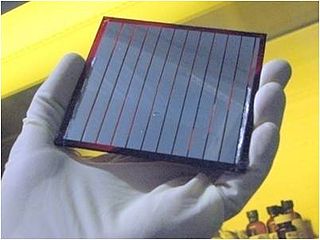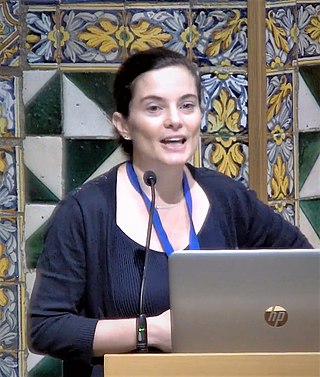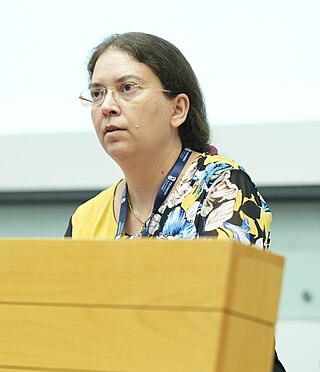
Molecular engineering is an emerging field of study concerned with the design and testing of molecular properties, behavior and interactions in order to assemble better materials, systems, and processes for specific functions. This approach, in which observable properties of a macroscopic system are influenced by direct alteration of a molecular structure, falls into the broader category of “bottom-up” design.

An organic solar cell (OSC) or plastic solar cell is a type of photovoltaic that uses organic electronics, a branch of electronics that deals with conductive organic polymers or small organic molecules, for light absorption and charge transport to produce electricity from sunlight by the photovoltaic effect. Most organic photovoltaic cells are polymer solar cells.

Polymer-fullerene bulk heterojunction solar cells are a type of solar cell researched in academic laboratories. Polymer-fullerene solar cells are a subset of organic solar cells, also known as organic photovoltaic (OPV) cells, which use organic materials as their active component to convert solar radiation into electrical energy. The polymer, which functions as the donor material in these solar cells, and fullerene derivatives, which function as the acceptor material, are essential components. Specifically, fullerene derivatives act as electron acceptors for donor materials like P3HT, creating a polymer-fullerene based photovoltaic cell. The Polymer-fullerene BHJ forms two channels for transferring electrons and holes to the corresponding electrodes, as opposed to the planar architecture when the Acceptor (A) and Donor (D) materials were sequentially stacked on top of each other and could selectively touch the cathode and anode electrodes. Hence, the D and A domains are expected to form a bi-continuous network with Nano-scale morphology for efficient charge transport and collection after exciton dissociation. Therefore, in the BHJ device architecture, a mixture of D and A molecules in the same or different solvents was used to form a bi-continual layer, which serves as the active layer of the device that absorbs light for exciton generation. The bi-continuous three-dimensional interpenetrating network of the BHJ design generates a greater D-A interface, which is necessary for effective exciton dissociation in the BHJ due to short exciton diffusion. When compared to the prior bilayer design, photo-generated excitons may dissociate into free holes and electrons more effectively, resulting in better charge separation for improved performance of the cell.

Vinay Gupta is an Indian materials scientist and a former senior scientist at the Physics of Energy Harvesting department of the National Physical Laboratory of India. Known for his studies on organic solar cells, carbon nanotubes arrays and Förster resonance energy transfer, Gupta is a former Alexander von Humboldt Fellow. The Council of Scientific and Industrial Research, the apex agency of the Government of India for scientific research, awarded him the Shanti Swarup Bhatnagar Prize for Science and Technology, one of the highest Indian science awards, for his contributions to physical sciences in 2017.
Suning Wang was a Chinese-born Canadian chemist. She was a Professor of Chemistry, Research Chair and head of the Wang Group at Queen's University, Canada, having joined the Department of Chemistry at Queen's University in 1996. Wang worked on the development of new Organometallic chemistry and luminescent materials chemistry. Her research interests also included the work on organic Photovoltaics and Nanoparticle, stimuli-responsive materials as well as OLEDs. Wang and her group developed a simple method of producing graphene-like lattice through light exposure, which may contribute to a huge field of future use. Wang held several patents related to the application of luminescent compounds and boron compounds.
Rachel Claire EvansFLSW is a Welsh chemist based at the University of Cambridge and a fellow of Jesus College, Cambridge. She works on photoactive polymer-hybrid materials for solar devices, including organic photovoltaics and stimuli-responsive membranes.

Natalie Stingelin, Fellow of the Materials Research Society and Royal Society of Chemistry, is a materials scientist and current chair of the School of Materials Science and Engineering at the Georgia Institute of Technology, the University of Bordeaux and Imperial College. She led the European Commission Marie Curie INFORM network and is Editor-in-Chief of the Journal of Materials Chemistry C and Materials Advances.

Ursula Röthlisberger is a professor of computational chemistry at École Polytechnique Fédérale de Lausanne. She works on density functional theory using mixed quantum mechanical/molecular mechanical methods. She is an associate editor of the American Chemical Society Journal of Chemical Theory and Computation and a fellow of the American Association for the Advancement of Science.
Emily A. Weiss is the Mark and Nancy Ratner Professor of Chemistry and director of the Photo-Sciences Research Center at Northwestern University. Her research considers the optical and electronic properties of nanostructures, including hybrid organic–inorganic quantum dots. She was a two-time finalist in the Blavatnik Awards for Young Scientists.
Katrina Anne Jolliffe is an Australian supramolecular and organic chemist and professor at the University of Sydney.

Majed Chergui is a Swiss and French physicist specialized in ultrafast dynamics of light-induced processes. He is a professor at EPFL, head of the Laboratory of Ultrafast Spectroscopy at EPFL's School of Basic Sciences, and founding director of the Lausanne Centre for Ultrafast Science (LACUS).

Clémence Corminboeuf is a Swiss chemist who is Professor of Computational chemistry at the École Polytechnique Fédérale de Lausanne. She was awarded the Swiss Chemical Society 2021 Heilbronner-Hückel Award.

Bin Liu is a chemist who is Professor and Provost's Chair at the National University of Singapore. Her research considers polymer chemistry and organic functional materials. She was appointed Vice President of Research and Technology in 2019. She was awarded the 2021 Royal Society of Chemistry Centenary Prize.

Lilo Danielle Pozzo is an American chemical engineer who is a professor of chemical engineering at the University of Washington. Her research considers the development, measurement and control of molecular self-assembly. She is interested in the realization of materials for energy storage and conversion. Pozzo serves on the editorial board of the Royal Society of Chemistry journal Digital Discovery.
Sahika Inal is a Turkish scientist who is an associate professor and Chair of the Organic Bioelectronics Laboratory at King Abdullah University of Science and Technology. She is interested in the use of organic electronic materials for monitoring health, and the design of biocompatible devices that can interface with the human body. In 2021, she was shortlisted for the Nature Portfolio Scientific Achievement award.
Oana Jurchescu is a Romanian physicist who is the Baker Family Physics Professor at Wake Forest University. Her research considers charge transport in organic and organic/inorganic hybrid semiconductors. In 2022, she was awarded a National Science Foundation Special Creativity Award for her work translating organic electronic materials into real-world devices.
Ellen Moons is a Belgian materials scientist who is a professor at Karlstad University. Her research considers the organisation of molecules and materials in thin films. She is mainly interested in organic and hybrid materials for solution processed photovoltaics.

Ana Flávia Nogueira is a Brazilian chemist who is a Full Professor at the State University of Campinas (Unicamp) since 2004. Her research considers nanostructured materials for solar energy conversion. She was elected to the Brazilian Academy of Science in 2022.
Alison Wendlandt is an American chemist who is an assistant professor at the Massachusetts Institute of Technology. Her research considers the development of catalysts for organic synthesis.

Maytal Caspary Toroker is an associate professor in the Department of Materials Science and Engineering at Technion-Israel Institute of Technology, Haifa, Israel. She is recognized for her significant contributions in the field of computational materials science, particularly in its applications to catalysis, charge transport, and energy conversion devices.











